To help beat the heat this summer, take a cue from shade-loving plants and get out of the sun, for at least part of the day. If you have shady spots in your outdoor space, there are native plants that can handle, or even thrive, in shade and support native wildlife.
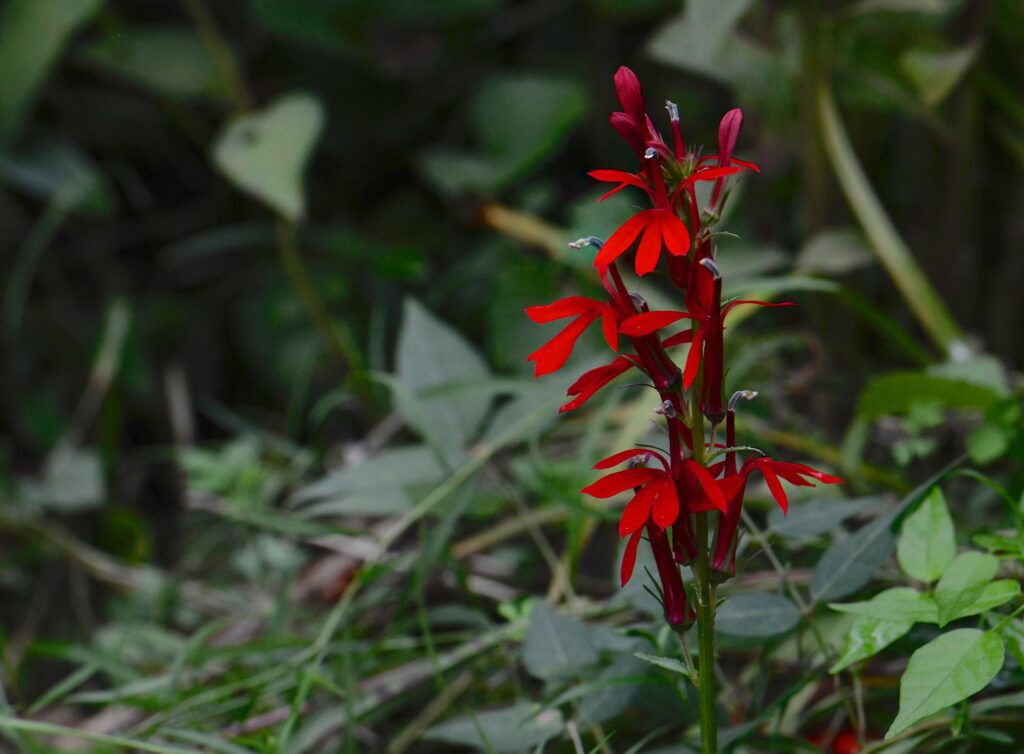
Cardinal flower. Photo by Tab Tannery
Shade-tolerant native plants can thrive in the following conditions, often categorized as part shade:
- Less than four hours of full sun, ideally during cooler parts of the day
- Shifting light throughout the day from taller trees like pines
- Soft, dappled light filtering through tree canopies
However, even shade-tolerant plants may struggle in:
- Deep shade where no sun reaches the ground
- Spaces shaded by solid structures like buildings or fences
- Poor soil conditions—especially areas that are too dry, too wet, or have dense root competition
Understanding your garden’s light patterns is key to creating a thriving native plant habitat, even in shady spots. If you’re starting or adding to a shade garden, consider including some of these native plants.
Ground Covers
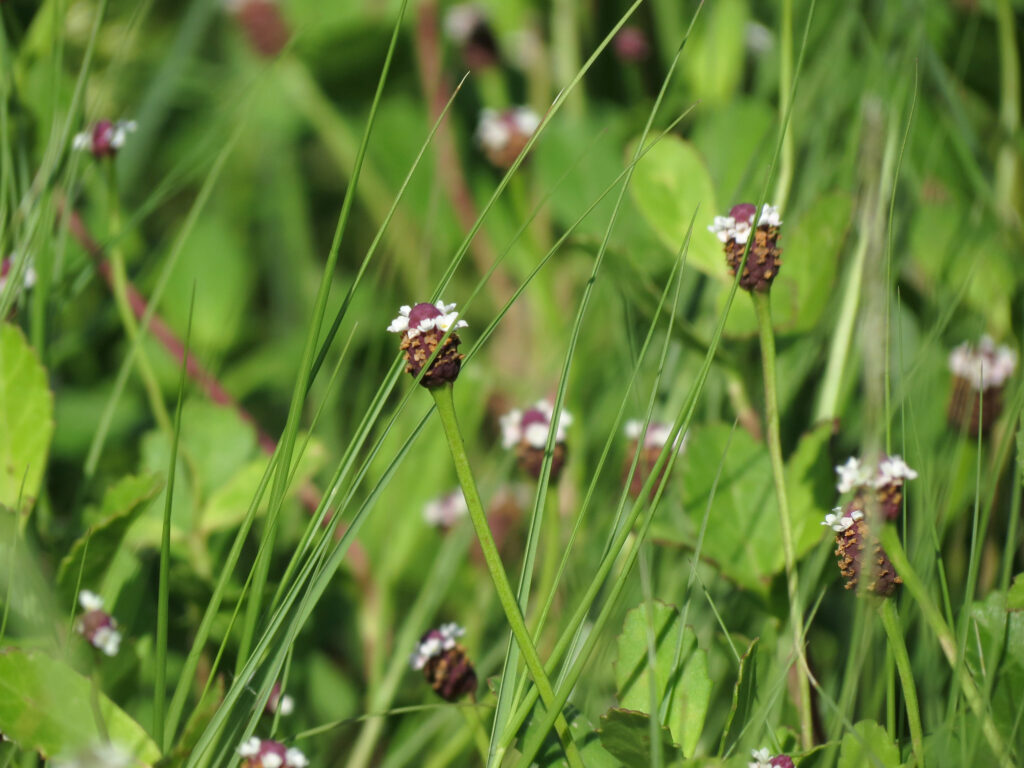
Frogfruit. Photo by Katja Schulz
Frogfruit (Phyla nodiflora) is a versatile native ground cover, found throughout the state, in sun to part shade. Growing up to 6 inches tall, with small white and purple flowers, it can replace turf grass areas with low foot traffic. This hardy ground cover provides nectar for bees and small butterflies and is the larval host for three species of butterfly caterpillars.
Twinflower (Dyschoriste oblongifolia), another native ground cover, grows 6 to 12 inches in height, does well in sun to part shade, and can be grown through most of the state. Small lavender flowers bloom in early spring through summer. Many native pollinators, especially bees, are attracted to this plant and it’s a larval host for the common buckeye caterpillar.
Lyreleaf sage (Salvia lyrata) can be seen on roadsides or disturbed sites from the Panhandle through most of Florida. A sea of blue and lavender flowers blooming in spring, tops 12-to-18-inch plants. Like our other native ground covers, its flowers attract many pollinators and it does well in sun to part shade.
Ferns
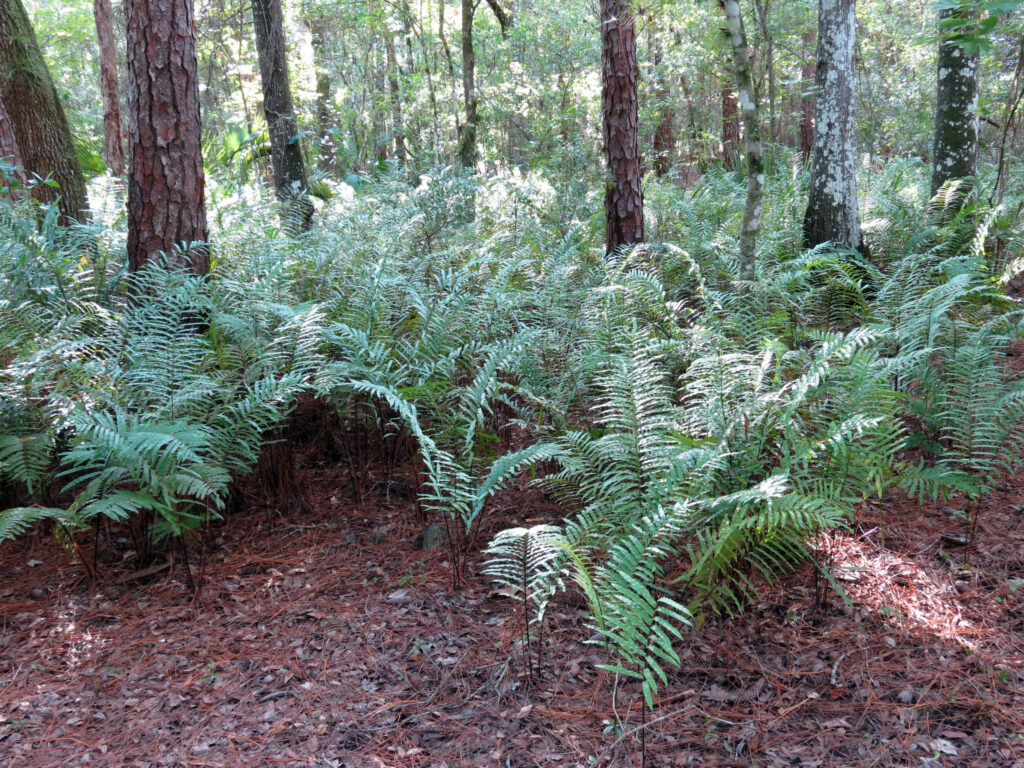
Swamp fern. Photo by Katja Schulz
Swamp fern (Telmatoblechnum serrulum) is one of the most common native ferns in Central to South Florida. This beautiful fern grows up to 4 feet in moist areas of part to full shade. New growth is copper colored and turns dark green as the plant matures. Swamp fern spreads vigorously. It can be grown in a large container to keep in a smaller space if needed.
Maidenhair fern (Adiantum capillus–veneris) grows in full to part shade in moist soils. In its natural setting, it’s sparsely distributed throughout the state, mostly where limestone is close to the surface. This low-growing fern does well in rock gardens and when planted near limestone or concrete.
Wildflowers and Shrubs
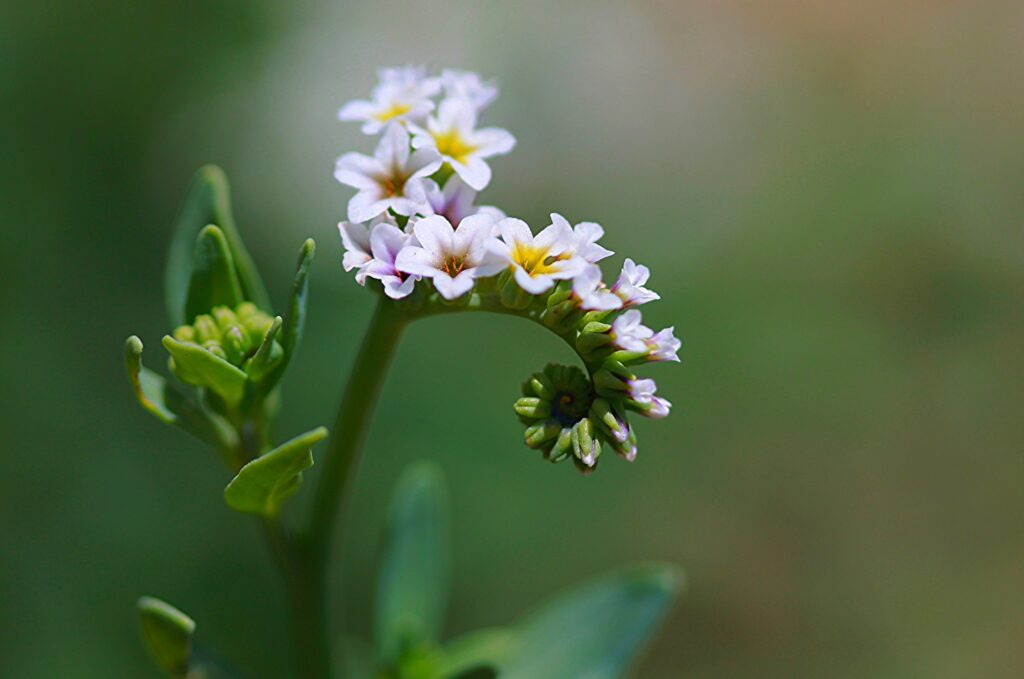
Scorpions-tail. Photo by Renee Grayson
Scorpions–tail (Heliotropium angiospermum) is a small, dense shrub found from Central Florida to the Keys. Tiny white flowers bloom year-round on a coiled or curved stalk, attracting numerous species of butterflies to its nectar.
Mistflower (Conoclinium coelestinum) grows throughout Florida, blooming in late summer to fall with clusters of flowers in blue and purple hues. Another native that can grow in sun to part shade, it provides nectar for skipper butterflies and bees.
Senicio or golden ragwort (Packera aurea) occurs naturally in Liberty, Gadsden, and Leon counties but can be grown in Central Florida in a garden setting. Golden-yellow flowers bloom in March, providing for pollinators early in spring. Senecio will do well in areas with full to part shade and moist soil and can be a good choice for rain gardens.
Cardinal flower (Lobelia cardinalis) is found in from the Panhandle to Central Florida in sun, part sun, and shade. Brilliant spikes of red flowers bloom in summer through fall, providing nectar for hummingbirds and butterflies.
American beautyberry (Callicarpa americana) is a woody, native shrub found statewide, growing 3 to 8 feet in sun to part shade. Its magenta-colored clusters of fruit are food for many bird species, and its small pink or lavender flowers attract pollinators, especially bees.
Wild coffee (Psychotria nervosa) offers a good choice for shade gardens from the Peninsula to the Keys. With glossy, evergreen foliage it can thrive in part to full shade. Small white blooms in spring to summer attract a variety of pollinators, and red berries feed birds and small mammals.
Trees
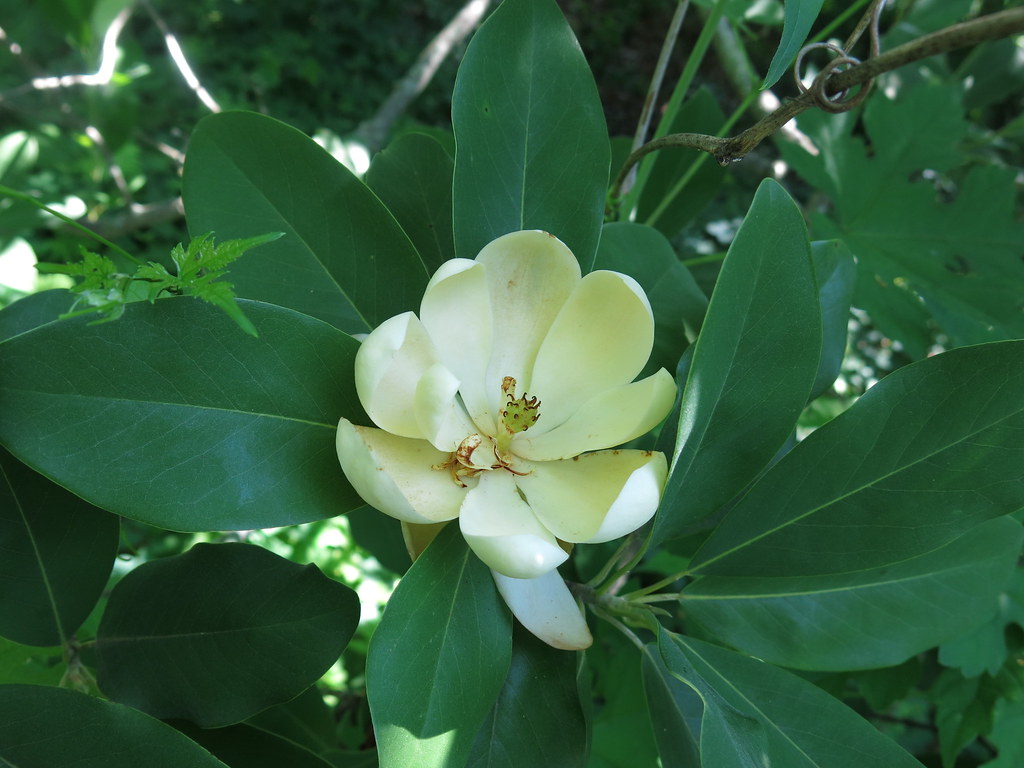
Sweetbay magnolia. Photo by Matt McDermitt
Sweetbay magnolia (Magnolia virginiana), a beautiful native tree, thrives in part shade to sun throughout Florida. Best recognized by its showy, white flowers and silvery leaves that are thinner and lighter weight than those of the larger southern magnolia. Growing 30-60 feet, this excellent wildlife tree attracts butterflies and pollinating beetles to its flowers, and numerous birds and other wildlife to its seeds and fruit.
Hornbeam or blue beech (Carpinus caroliniana) can thrive in part to full shade in the Panhandle to Central Florida. Reaching 30 feet, it provides fall color and is a larval host for several butterfly caterpillars.
Gumbo-limbo (Bursera simaruba) is native to coastal areas of Central Florida and throughout the southern peninsula in part shade to sun. An attractive specimen tree with bronze-colored peeling bark, it supports bees, other insect pollinators, and birds with flowers and fruit. Also called the tourist tree, it can grow to 60 feet but is usually smaller in landscapes.
Ask the Pros
Descriptions of preferred light exposure, soil moisture, growing zones, blooming times, and growth habits of plants can get confusing. Professionals at local native plant nurseries can offer advice on choosing plants that can work in your setting, and tips on keeping them healthy. They can help you match the right plants to your yard’s unique conditions.
For more information about using your garden to support native wildlife, visit our Gardening for Wildlife in Florida resources.



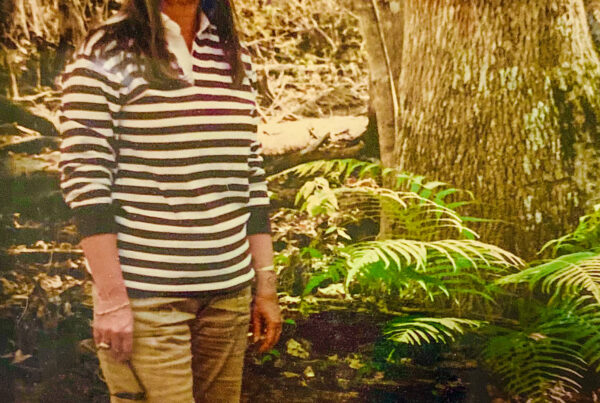
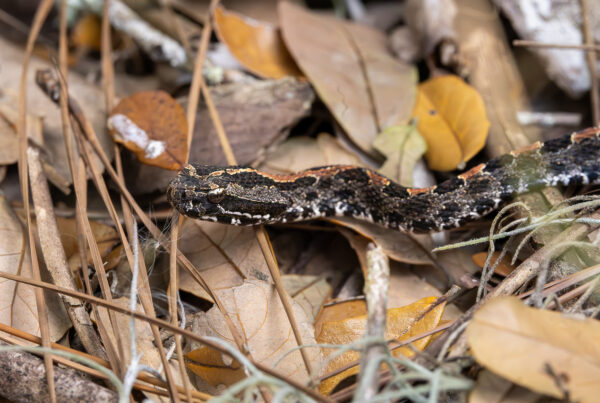
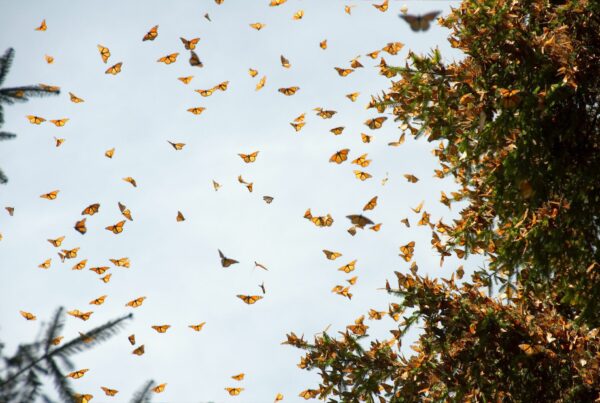

I enjoyed the read about the longest snake in the United States plus the blooming flowers afterwards! A good read! Thx for sharing w. panther @ wvp2@aicloud.com